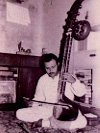On January 27, 1986, the world lost one of its finest musicians at the young age of 54. Pandit Nikhil Banerjee, the quiet, unassuming sitar virtuoso, passed away two days after he had played Darbari Kanada and Hemant at the Dover Lane Music Conference in Calcutta despite severe illness. It was his younger daughter Debdatta's birthday -- a relative had arrived with a cake for the little girl. Panditji got up to greet the guest and collapsed immediately. The fingers that he had punished into unreal command over his instrument would glide over it no more.
"Mr. Banerjee", as he liked to be called, was a musician's musician. Uncompromising in his performances, he brought to the stage an unparalleled level of commitment, focus and tayyari (preparation). His leisurely alaaps, elaborate gatkari and blinding taans have rarely been equalled. But he also maintained a strongly individual presence, distinct from his illustrious contemporaries Pandit Ravi Shankar and Ustad Vilayat Khan. In the words of Ustad Ali Akbar Khan:
"The style of alaap of our gharana -- unhurried, steady -- has always been present in his alaaps. But the truly personal element of his playing was his "feeling". Music is essentially sa-re-ga-ma, there is nothing beyond it. But that "feeling" is a truly individual achievement. And Nikhil had just that. You could call it his personal "touch" or "behaviour" in his playing. Of course, the road has to be shown by the guru. So one can say that by travelling on the road shown by Baba [Ustad Allauddin Khan] Nikhil has found his own road."
"In India, [music] was practised to know the Supreme Truth. It is not only for the entertainment of the people, no. When we play for the people -- perhaps I cannot play that beautiful music, but I try -- but idea is to lift up the mind of the listeners, and place them in front of the space, or you know, you can say God, you can say power, you can say energy... You have seen perhaps, specially in Western music, Western musicians in their old age, they take their instruments and go to church and play. It is not the church or the building. He is playing not for the public, but for something else. Because through music you can earn lot of money, fame, but that cannot give you satisfaction of mind. Your mind can only be satisfied when you play for the something else and tell that, you know, this is what I want to express through my music. So it is said in India that my music cannot see Him or touch Him, but my music touches His feet."
Mr Banerjee, it is twenty years since you left us to play closer to the feet of the Something Else. Thank you for the notes you left behind.
********
At this point, let me put in as strong a plug as I possibly can for Steven Baigel of Berkeley, California, who is making a documentary on Nikhil Banerjee. Steven is a wonderful and committed guy who has undertaken this labour of love with virtually no funding and very little material to work with. He has personally recorded a huge number of precious interviews with people who knew and worked with Nikhil Banerjee, including Ali Akbar Khan and Swapan Chaudhuri, and collected the few concert videos that exist, and has put together a 12 minute sample, available at his website. Trust me, the finished film will blow the sample to bits, good as it is. BUT, and this is the big but, he needs your support. If you know of any material (preferably visual) that you can lay your hands on, please do contact him. If you know of anybody willing to contribute financially to the project (broadcasting rights for concert footage cost big bucks), again, please do contact him. Heck, contact him anyway and let him know you're with him :).
Throughout the weekend, Nikhil Banerjee will play on Besur Betal Betar.
For more on Mr. Banerjee, the following websites may be useful:
- John Wilton's Raga Records, with a long interview by Ira Landgarten.

